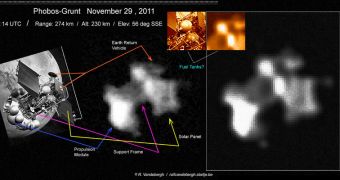The United States Strategic Command reportedly now lists pieces of the Russian-built Phobos-Grunt spacecraft as part of the large batches of space junk clogging Earth's orbit. Additional pieces of the probe are believed to have already reentered Earth's atmosphere, burning up high in the sky.
It would now appear that, despite concentrated efforts from the Russian Federal Space Agency (RosCosmos) and the European Space Agency (ESA), the sample-return mission is beyond help.
Though numerous attempts have been made to contact the spacecraft, there was only moderate success in doing so. At one point, an ESA ground-based antenna was able to pick up a signal from Phobos-Grunt, but that contact was eventually lost, and never reestablished.
Various commands RosCosmos engineers sent to the spacecraft – mostly diagnostics and engine-start requests – have been left unanswered, and no discernible effect was made out in the probe's orbit around the planet, Space reports.
The orbit in which a Soyuz rocket injected the spacecraft is not entirely stable, and is also very low. This may be one of the reasons why small pieces from the vehicle are already beginning to come loose, and fall down to Earth.
Space experts say that it's entirely common for rockets and space probes to begin losing components at such small altitudes. Thus far, two pieces of debris were identified as having separated from Phobos-Grunt. However, they are most likely not essential to the spacecraft.
This conclusion was reached after investigators discovered no modification in the spacecraft's orbit after the separation occurred. Regardless, analysts see the Russian mission as dead in the water, and with little chances of being restored.
Phobos-Grunt was launched on November 8, from the Baikonur Cosmodrome, in Kazakhstan. As a sample-return mission, its main purpose was to enter orbit around the Martian moon Phobos, and then deploy a Chinese-built satellite in orbit around the Red Planet.
The next stage of the mission would have been the deployment of a small lander to Phobos' surface. The robot would have collected a few rock samples, and then blast off from the object, and set itself on a course towards Earth.
Once here, it would have parachuted its load through the atmosphere, allowing geologists to finally solve a lot of mysteries related to Phobos and Mars. One of the most important is the nature of the moon itself, since some say it's an asteroid, while others believe it was produced by a cometary impact.
ESA has already announced that it will discontinue tracking support for Phobos-Grunt, after consultations with RosCosmos.
“Efforts in the past week to send commands to and receive data from the Russian Mars mission via ESA ground stations have not succeeded; no response has been seen from the satellite. ESA teams remain available to assist the Phobos-Grunt mission if indicated by any change in the situation,” an ESA announcement reads.

 14 DAY TRIAL //
14 DAY TRIAL //